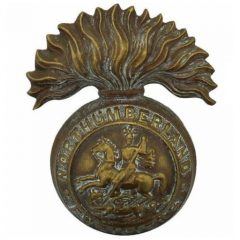Wulverghem The following morning the officers reconnoitred the front line east of Wulverghem village in readiness for the Bn moving up to the trenches later that day. Foster: “All CO’s and Captains of Companies…
You must be logged in to view the content of this Chapter.
Footnotes
- Souvenir Farm lay 200 yards east of Wulverghem, to the north of the Messines road. The 4th NF supplies were here. Ploegsteert Map 28SW4: Map Ref: T.5.d.5.7
- These dugouts were named after the 46th (North Midland) Divn who has occupied this part of the line prior to the 50th Divn
- Capt Francis Buckley published his memoirs in a book entitled ‘Q.6.a and Other Places’
- Sgt Peter Flanagan
- RC Farm
- British Hand Grenades [zotpress items="J43364UC" style="apa"]
- Five to seven seconds
- The Pippin entered service in June 1915
- Lt Charles Osborne Provis Gibson
- Frederick Rudolf Lambart, 10th Earl of Cavan (1865-1946) was commissioned into the 2nd & 4th Guards Bde and eventually commanded them. He was transferred to the 50th Divn on promotion, but two months later was appointed to command the Guards Divn
- In 1914 Maj. Gen. Sir Walter. F. L. Lindsay was in command of the Royal Artillery units of the BEF. He was sacked from command of the 50th Divn by V Corps commander Allenby in June 1915. ‘A charming man but physically old and not an efficient commander of a division’
- Henry Frederick Hugh Clifford (1867-1916) grandson of the 7th Baron of Chudleigh
- A ‘Woolly Bear’ was a German shrapnel shell that burst with a cloud like explosion
- 2nd Lt Thomas William Gregory
- Crusts -
- Pte Edward Francis McClafferty (4/1741) ‘C’ Coy had previously been wounded on the 26th of April 15
- 2nd Lt Wilfrid Walter Varvill was mentioned in the London Gazette supplement ‘For conspicuous gallantry, energy and skill between 10th and 17th July, 1915, near Wulverghem, when the enemy was attempting to blow up our trenches by mining’ (London Gazette, p. 8843). Varvill transferred to the RE soon afterwards
- Sgt George William Burns (4/1870) (e. Hexham). The Hexham Courant and Herald newspapers (31 Jul 15) reported that he had been dangerously wounded in the neck, arm and leg. He died in Boulogne hospital on the 22nd of Jul 1915 and is buried in Boulogne Eastern Cemetery
- A counter mine was a tunnel dug below the attacker’s tunnel. An explosive charge known as a camouflet was positioned in the counter mine and detonated in order to collapse the enemy tunnel. This could also cause extensive damage in the defenders area, particularly if the enemy tunnel had already been packed with explosives
- ‘Coal box’ was the British soldier’s slang name for a heavy German shell, usually 5.9-inch calibre, which gave off black smoke on detonation.(Anon., 1915).
